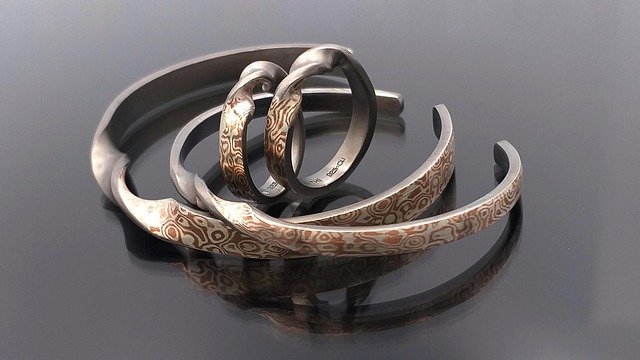Exploring Jewelry: Types, Materials, and How It Is Made
Jewelry comes in many shapes and styles, from rings and necklaces to bracelets and earrings. This article explains the materials used, the techniques for crafting different pieces, and how designs have evolved. Learn how artists create beautiful items people enjoy wearing every day.

Common Types of Jewelry Throughout History
Jewelry categories have evolved significantly over centuries while maintaining certain fundamental forms. Rings, perhaps the most universally recognized jewelry type, have symbolized everything from marital commitment to authority and wealth across diverse cultures. Necklaces range from simple pendants to elaborate statement pieces with multiple strands and components. Earrings, once primarily worn by nobility in many civilizations, have become everyday accessories available in countless styles from studs to elaborate chandeliers. Bracelets and anklets adorn limbs in various materials and designs, while brooches and pins serve both decorative and functional purposes. Additionally, specialized forms like tiaras, body chains, and nose ornaments reflect cultural traditions and fashion trends specific to different regions and eras.
Essential Jewelry Materials and Their Properties
The materials used in jewelry creation significantly influence a piece’s appearance, value, and durability. Precious metals form the foundation of many jewelry items, with gold prized for its lustrous appearance and resistance to tarnishing, available in various karats indicating purity. Silver offers affordability with elegant appearance but requires occasional polishing to prevent oxidation. Platinum provides exceptional durability and hypoallergenic properties at a premium price. Gemstones introduce color and brilliance, with diamonds, rubies, sapphires, and emeralds traditionally considered precious stones, while semi-precious options like amethyst, garnet, and topaz offer diverse hues at more accessible price points. Modern jewelry also incorporates alternative materials including stainless steel, titanium, silicone, wood, glass, and various types of plastic, expanding design possibilities and price ranges to suit different preferences and occasions.
Traditional Jewelry Crafting Techniques
The creation of jewelry relies on various time-honored techniques that artisans have refined over centuries. Metalworking forms the core of many jewelry production methods, with casting allowing for the reproduction of intricate designs by pouring molten metal into molds. Forging involves physically manipulating metal through hammering to create texture and shape. Soldering joins separate metal components using heat and a filler metal, essential for assembling complex pieces. Stone setting techniques vary based on the desired appearance and security, from prong settings that elevate gems for maximum light exposure to bezel settings that encircle stones with metal for protection. Filigree work creates delicate, lace-like metal designs by twisting and arranging thin metal wires, while granulation adds texture through tiny metal spheres arranged in patterns and fused to the surface. Many contemporary jewelry makers continue to employ these traditional methods alongside modern technologies.
Modern Jewelry Manufacturing Processes
Today’s jewelry production balances traditional craftsmanship with technological innovation. Computer-aided design (CAD) software enables jewelers to create precise digital models before physical production begins. These digital designs can be brought to life through 3D printing, either producing wax models for casting or directly creating metal pieces through selective laser sintering. Laser cutting and welding provide unprecedented precision for cutting metal components and joining pieces together without the heat spread of traditional soldering. Mass production techniques, including die-striking and stamping, allow for consistent replication of designs at scale. Despite these technological advances, many high-end jewelry houses and independent artisans maintain a commitment to hand-finishing techniques, recognizing that the human touch adds character and quality that machines cannot replicate, creating a harmony between innovation and tradition in modern jewelry making.
The Evolution of Jewelry Design Through Cultures and Eras
Jewelry design has continuously evolved, reflecting changing cultural values, available technologies, and artistic movements. Ancient civilizations created symbolic adornments using locally available materials—Egyptians favored gold and colorful glass, while Mesoamerican cultures worked with jade and feathers. The Renaissance period brought renewed interest in classical motifs and innovations in stone cutting techniques. The Victorian era introduced sentimental jewelry containing locks of hair or miniature portraits, while Art Nouveau emphasized flowing, nature-inspired forms. Art Deco subsequently embraced geometric precision and bold color contrasts. The mid-20th century saw modernist minimalism gain popularity, followed by the experimental, often conceptual approaches of contemporary jewelry artists who challenge traditional definitions of wearable art. Throughout this evolution, cross-cultural exchange has consistently enriched design possibilities, with global influences increasingly visible in today’s interconnected jewelry market where traditional techniques from diverse cultures inform contemporary creations.
Jewelry Care and Maintenance Essentials
Proper maintenance extends the life and beauty of jewelry pieces regardless of their material or value. Different materials require specific care approaches: precious metals benefit from regular cleaning with mild soap solutions and soft cloths, while gemstones may need specialized attention based on their hardness and sensitivity. Professional cleaning and inspection are recommended annually for fine jewelry to identify and address potential issues before they worsen. Proper storage prevents scratching and tangling—individual pouches or compartmentalized boxes keep pieces separated and protected. Environmental factors like chemicals in swimming pools, household cleaners, and even personal care products can damage certain materials, making it advisable to remove jewelry before exposure. Understanding the specific vulnerabilities of your pieces—whether gold’s softness, silver’s tendency to tarnish, or certain gemstones’ sensitivity to light or heat—enables appropriate preventive care, preserving both the aesthetic appeal and monetary value of jewelry collections.
Jewelry represents one of humanity’s most enduring art forms, combining aesthetic appeal with cultural significance and technical mastery. From ancient amulets to contemporary wearable sculptures, the diversity of jewelry types, materials, and manufacturing techniques continues to expand, offering endless possibilities for personal adornment and artistic expression. Whether created through traditional handcrafting methods or cutting-edge technology, jewelry’s ability to convey meaning, status, and beauty ensures its continued relevance across cultures and generations.




